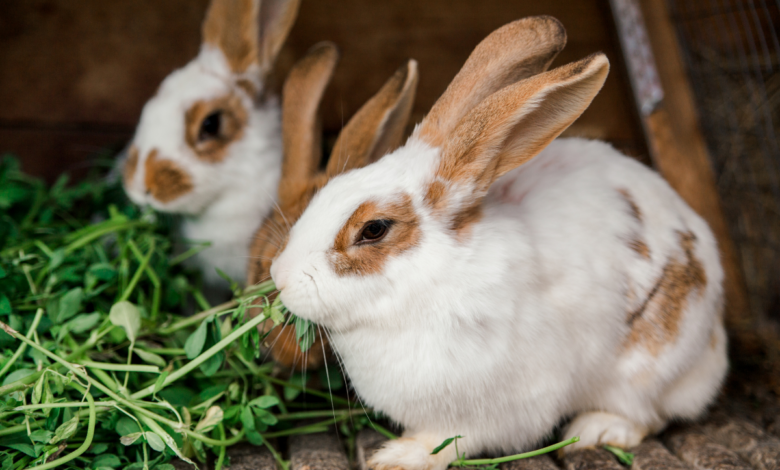Homeowner’s Guide to Meat Rabbits: Raising Them Up Right

If you’re all about living a self-sustaining life, then you need to get on the meat rabbit train. Meat rabbits are such a game changer when it comes to producing your own protein right at home. As someone who has been raising meat rabbits for years, let me give you all the details on why they are a must-have for any homestead.
Check out the latest rabbit recipe from Shellys Game Kitchen!
What Is a Meat Rabbit?
Meat rabbits are a special breed of rabbit that has been specifically developed for efficient meat production. They grow much larger and faster than rabbits typically kept as household pets. Some popular meat breeds include the New Zealand, Californian, Flemish Giant, Satin, and Champagne D’Argent — these aren’t the types of rabbits that you’d be able to get when rabbit hunting with your beagle.
These rabbits can reach about 5 to 10 pounds in just 8 to 12 weeks, since they gave the ability to rapidly pack on muscle.
Meat rabbits also have a wider and stockier body type compared to their leaner and leggier rabbit cousins. This dense muscle mass translates to maximum meat yield when it comes time for butchering.
Benefits of Raising Rabbits for Meat
First, let’s talk about why meat rabbits should be at the top of your livestock list. Rabbits are one of the most productive and low-maintenance livestock animals that you can raise on a homestead. A couple of breeding rabbits can quickly multiply into a steady supply of meat with very little input required on your end.
They have incredibly short gestation periods of just 31 days, and does can be rebred immediately after having a litter. Since they have such a frequent reproduction cycle, it means you have a steady rotation of rabbits ready for butchering year-round.
Compared to other meat animals, rabbits require far less feed, water, and space — yet they can produce an impressive amount of high-quality protein in return. A single buck and two doe rabbits can give you around 100 pounds of flavorful, low-fat meat annually if you breed and manage them properly.
Here are more reasons why rabbits are an incredibly smart choice for homesteaders looking to maximize self-sufficiency:
Sustainability
As homesteaders, we are always looking for ways to reduce our environmental impact, and rabbits hit that nail right on the head.
Compared to larger livestock, like cattle or pigs, rabbits have such a tiny ecological footprint. They don’t require huge amounts of land or a ton of feed, yet they produce the tastiest lean meat.
More Efficient Than Other Livestock
Efficiency is key when you’re living off the land, and rabbits are truly champions here. Rabbits grow from tiny kits to slaughter weight in just a few short months — and we can’t forget about how fast they reproduce.
A single breeding doe can potentially produce over 50 offspring in just one year — a true protein-packed return on investment.
They Eat Common Vegetation
One of the best things about raising rabbits is that you can significantly cut down on feed costs by letting them munch on the plant matter that is growing all around you.
If you’re wondering what to feed meat rabbits, rabbits are grazers and will happily chow down on gross, weeds, plants, and other leafy greens that you might consider to be a nuisance.
Can Be Raised in Small Spaces
Even if your homestead is on the smaller side, you can still raise meat rabbits. These little guys don’t need acres upon acres of land to thrive — a simple backyard hutch or colony setup is all it takes to start producing your own rabbit meat. As long as you have a little bit of outdoor space, you’re in business.
How to House Meat Rabbits
Now that you’re sold on adding meat rabbits to your homestead, it’s time to set up some space for them. The key is to create a clean and well-ventilated living space that meets all of their basic needs. So, you have a couple options:
Hutches
The most classic type of rabbit housing solution is a good old-fashioned hutch. These standalone structures can be purchased pre-made or you can build one yourself out of wood and wire mesh.
Just make sure to provide at least 4 to 5 square feet of space per adult rabbit, along with a nesting box for your does and their litters.
Colony Setup
Another popular option is to create a colony-style setup with interconnected cages and nesting boxes. This allows your rabbits to move freely between sections while still being contained. Colony setups are a great way to mazimize your space and enable your rabbits to display more natural behaviors.
Whichever route you take, the key is to keep their spaces clean, dry, and well-ventilated. Try to spot-clean daily and do full bedding changes regularly so you can prevent any nasty odors or health issues.
What to Feed Meat Rabbits
Now that you have their housing sorted, let’s talk about their diet. As grazers, rabbits need a steady supply of fresh hay or grass to keep their digestive systems running smoothly. You can supplement their leafy diet with a high-quality rabbit pellet for added protein and nutrients.
The best part is that a huge chunk of your rabbits’ feed can come straight from your homestead. All you have to do is gather up grass clippings, weeds, garden scraps, and other plant matter from around your property and feed it to your hungry rabbits.
Not only does this make use of potential “waste” vegetation, but it also means that you’ll be relying less on purchase feed, saving you money while reducing your dependency on external sources.
Oh, and we can’t forget about fresh water. Rabbits need plenty of hydration to stay healthy and productive, so make sure their water supply is always clean and readily available for them to access.
Frequently Asked Questions
What type of meat is rabbit?
If you’ve never cooked with rabbit before, you’re honestly in for a real treat. Rabbit meat is very lean and tender, and has a flavor that is often comparable to chicken, but slightly richer and gamier.
Meat rabbits are packed with protein and you can prepare it in all types of ways, like roasted, grilled, braised, stewed — the possibilities are endless.
My personal favorite way to cook rabbit is to slowly braise the meat until it’s fall-off-the-bone tender, and then use the cooking liquid to make a rich gravy or sauce. But don’t just take my word for it — experiment and find your own favorite way to enjoy it.
Plus, rabbit meat is easy to preserve and can be refrigerated safely for up to two days and frozen indefinitely.
Is raising rabbits for meat humane?
As homesteaders, we tend to care a lot about the ethical treatment of our livestock. But yes, raising meat rabbits can absolutely be done in a humane and respectful way.
The key is to provide them with ideal living conditions — like spacious housing, proper nutrition, and a clean environment — and to handle them as humanely as possible.
Many homesteaders choose to process their own rabbits at home, which allows for a quick and low-stress harvesting experience, as opposed to loading them onto a truck for a long journey to a processing facility.
If you’re not comfortable with the hands-on harvesting yourself, you can look for a small-scale processor who follows ethical slaughtering practices.
How much space do I need?
The amount of space you’ll need for your meat rabbit operation really depends on the scale you want to take it to.
A small backyard colony for supplementing your household’s protein intake can be done in a relatively compact space. But if your goal is to produce meat rabbits for selling or feeding a larger group, you’ll want to go bigger.
Typically, you’ll want to provide at least 4 to 5 square feet of living space per adult rabbit, with an additional nesting box space for your pregnant does and their litters.
Of course, the more space you can provide, the better — but even if you have a modest backyard, you can still give your meat rabbits enough space.
What are the startup costs?
Raising rabbits for eating is one of the most affordable livestock options out there for homesteaders. The initial investment is pretty low compared to larger animals, like cows or pigs. Here’s a quick rundown of some of the typical startup costs:
- Breeding stock (a trio of rabbits — 1 buck and 2 does): $60-$150
- Housing (hutches, cages, nesting boxes): $100-$500
- Feeders, water bottles, other supplies: $50-$100
So just for a few hundred bucks, you can have a full-fledged rabbit meat production system up and running on your homestead. Plus, considering a breeding trio can potentially produce more than 100 pounds of meat per year, that’s an amazing return on investment.
Of course, you’ll need to factor in ongoing costs for feed, bedding, and other supplies. But compared to most other types of livestock, rabbits are amazingly affordable and efficient to raise for meat.
Final Thoughts
Now you have the rundown on everything you need to know on how to start adding meat rabbits to your homestead. These little hoppers check all the boxes — they’re low-maintenance, feed efficient, space saving, and most importantly, they’re delicious.
So why not give rabbit ranching a try? With modest startup costs and the potential for an ongoing supply of lean, healthy protein, raising a few meat rabbits is a no-brainer addition to any self-sufficient homestead.
Just provide them with good housing, proper nutrition, and a bit of daily attention. They’ll reward you with cage after cage of tasty and sustainable meat for your family’s table.



